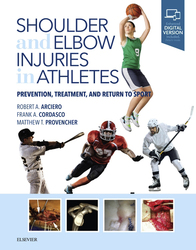Shoulder and Elbow Injuries in Athletes
Prevention, Treatment and Return to Sport E-Book
Format : eBook
Read this on :












Book Description
Thorough and concise, this practical reference provides a unique, on-field management approach to all athletic injuries to the shoulder and elbow, as well as nonoperative and operative treatment options, including arthroscopy and open surgery. Focusing on high-performance athletes, leading authorities in the field demonstrate how to provide pain relief, restore function, and return the athlete to sport and to prior level of performance in a safe and timely fashion.
- Showcases the knowledge and expertise of an international group of editors and authors who have served as president of the American Orthopaedic Society for Sports Medicine, the American Shoulder and Elbow Surgeons and the Arthroscopy Association of North America, are physicians or consultants for professional and collegiate sports teams, have won awards for research in the field of shoulder surgery, are editors and reviewers for peer-reviewed journals, and much more.
- Contains rehabilitation guidelines and critical return-to-sport protocols – essential information for nonsurgical healthcare providers -- primarily on athletes under the age of 40, with some consideration of the older athlete (professional golf, for example).
- Contains a section in each chapter covering "On-the-Field Management and Early Post-Injury Assessment and Treatment" – a must-read for immediate care of the injured athlete and ensuring the safe return to play.
- Covers the most recent advances in the management of tendon tears in elite and overhead athletes, including prevention in youth sports, early sports specialization, and changing standards of care regarding shoulder and elbow instability.
- Provides a thorough review of current ulnar collateral ligament injury diagnosis, imaging, non-operative management, and surgery, as well as acromioclavicular and sternoclavicular joint injuries, clavicle and olecranon fractures, and OCD of the capitellum.


 (0 rating)
(0 rating) 